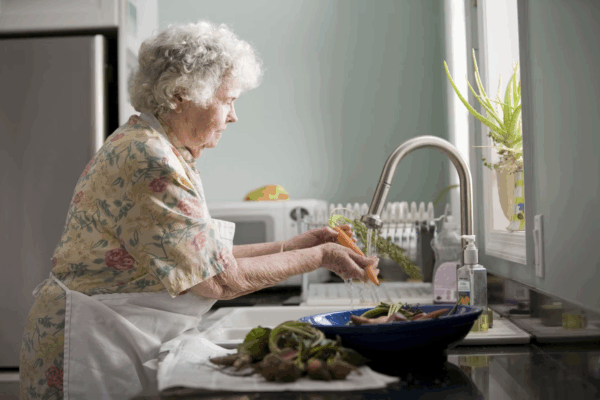Most of us want to age in place, but 90% of homes in Pennsylvania do not meet minimal accessibility standards for seniors and people with disabilities. Home modifications to age in place are increasingly popular—when done correctly, they improve the safety, comfort, and value of your home. Aging in place home modifications are more than generic ramps and grab bars; lighting, color, flooring, and home organization are also important factors in preparing a home for safe and happy aging.
Vision changes are a natural part of aging—a healthy 60-year-old needs three times more light than a healthy 20-year-old, and we perceive color and contrast differently as we age. Using multiple light sources in every room improves safety by decreasing glare and shadows. Nonglare lighting with color temperature over 3000K is recommended to maximize clarity. Under-cabinet lights in the kitchen illuminate cutting boards and cooking surfaces, decreasing eye strain and risk of injury while cooking. Motion-activated lights in commonly used areas such as bedrooms, hallways, and bathrooms are recommended to prevent falls at night. Improving the lighting in your home can be as easy as changing a lightbulb and makes your home a safer and more comfortable place.
The importance of color goes beyond lights and décor: color can be strategically used to improve home safety, depending on the needs of the family. Using contrasting colors for flooring, furniture, and appliances improves visibility, which prevents bumps, bruises, and falls. Safety features, such as grab bars and handrails, should always contrast with their background to make them easy to see. High-contrast anti-slip treads on stairs decrease the risk of someone missing a step. (However, repetitive stripes of certain shades trigger dizziness for some people.) An aging in place specialist can determine colors and patterns that meet the unique needs of your family while complementing the home’s existing décor.
Flooring considerations include friction (texture), compliance (softness), reflectiveness, and color. A hard, smooth floor provides little friction, making it easy to slip and fall. Falling on a softer floor has lower risk of injury, but thick shag carpets are difficult for people using walkers and other mobility equipment. The solution? Compliant flooring or low-pile carpet with PVC foam underlay minimize the risk of fall-related injuries. Non-reflective floor materials are recommended; a highly reflective floor creates glare under natural lighting, which hinders vision and can even be painful. If non-reflective flooring is not an option, consider anti-glare treatment for nearby windows. Also, a floor color that contrasts well with the walls and furniture improves visual clarity in the room and decreases the risk of bumps and falls.
Homes can be re-organized to reduce fall risk, fatigue, and “wear and tear” on joints. Thoughtfully placed shelves and tables can reduce clutter on floors, stairs, and around showers, which decreases the risk of falls. Strategically re-arranging furniture for energy conservation decreases fatigue with everyday activities. Re-organizing the rooms we use most changes the way we use our joints, which can go a long way in preventing pain and deformity in arthritic joints. Home organization is the simplest type of home modification, but the potential impacts on health and safety are significant.
Home modifications should always be designed with you in mind. Some people need grab bars installed at 32” height, while others need grab bars at 38”. An ADA-standard ramp is safe and effective for many people, but dangerously steep or too lengthy for others. High-contrast treads on steps are recommended to decrease fall risk; this can be very effective but can also trigger dizziness and increase fall risk for people with vertigo. Safety and style need not be at odds; lighting, safety flooring, anti-slip treads, handrails, and grab bars are available in many different styles, allowing homeowners to improve home safety without compromising aesthetics. Working with an occupational therapist with aging in place certification can maximize the benefits of home modification projects and prevent the need for further renovations in the future.
Change In Motion provides home modification evaluations led by a Certified Aging in Place Specialist (CAPS) occupational therapist (OT). Services are covered by Medicare, AmeriHealth Caritas, and most commercial insurance plans. For more information or to schedule a free consultation, call 484-240-5913 or visit ChangeInMotionPA.com.






